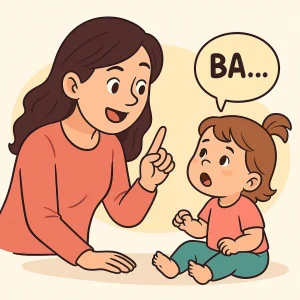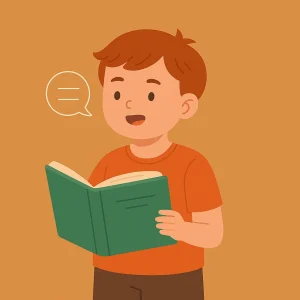Help Your Child Talk: Pediatric Speech Therapy Benefits
By Rajini D
Last Updated: May 3, 2024
Is your child struggling to express themselves clearly?
Speech and language delays can affect everything from emotional development to learning and social interaction. That’s where pediatric speech therapy plays a vital role.
Designed specifically for young learners, this specialized form of therapy helps children overcome challenges in communication—ensuring they don’t fall behind during the most crucial years of growth. Whether it’s difficulty with pronunciation, delayed speech, or limited vocabulary, early intervention can make all the difference.
Know more: Navigating Online Speech Therapy for Non-Verbal Children: A Guide for Parents and Educators
Understanding Pediatric Speech Therapy
Pediatric speech therapy is a specialized field dedicated to assessing and treating communication disorders in children. This therapy is crucial as it addresses a variety of issues that can hinder a child’s ability to articulate thoughts, understand others, and engage socially. The ultimate goal of pediatric speech therapy is not just to improve the child’s ability to speak, but also to enhance their overall communication skills so they can express themselves clearly and interact effectively with the world around them.
Within the realm of pediatric speech therapy, several common disorders are addressed:
- Articulation Disorders: These involve difficulties in making sounds in syllables or saying words incorrectly so that the listener can’t understand what’s being said. For instance, a child might say “wabbit” instead of “rabbit.”
- Language Disorders: These refer to troubles with understanding or using spoken or written language. A child with a language disorder may have difficulty expressing themselves, understanding others, or even using language in a socially appropriate way.
- Stuttering: This is characterized by disruptions in the normal flow of speech. These disruptions might include frequent repetitions of words or parts of words, prolonged sounds, or the complete inability to produce a sound.
- Voice Disorders: These involve problems with the pitch, volume, or quality of the voice. A child may have a hoarse or harsh voice which can affect how easily they are understood.
- Communication Disorders: These can range from simple speech delays to more complex conditions such as autism spectrum disorder, which affects how a child communicates and interacts with others socially.
Developmental Milestones in Speech and Language
As parents, watching your child’s development unfold is one of the most exciting aspects of early parenthood. From their first word to their ability to hold a conversation, each stage of speech and language development is a significant milestone.
Key Developmental Milestones
From Infancy to School Age:
- 0-6 Months: Babies start to coo and make pleasure sounds. They respond to their name and begin to recognize words for common items like “cup” or “shoe.”
- 7-12 Months: Babbling begins, incorporating more consonant sounds. Babies start to use gestures like waving goodbye and may say one or two words like “mama” or “dada.”
- 1-2 Years: At this stage, vocabulary begins to expand rapidly. Children start to put two words together, forming simple sentences such as “more milk” or “go out.”
- 2-3 Years: Children begin to use language to ask for things, tell stories, and speak in longer more complex sentences. They can usually be understood by family and frequently interact with peers using language.
- 3-5 Years: Vocabulary continues to grow, and grammar starts to improve. Children can narrate stories, understand instructions, and are capable of conversation with adults and other children.
- 5-7 Years: Children start to understand jokes, can engage in detailed conversations, and their speech is mostly clear and well-formed.
Monitoring and Recognizing Delays
Understanding these milestones is crucial, not just for academic readiness but for social skills and emotional development. Early detection of any delays is vital because the sooner an issue is identified, the sooner it can be addressed. Signs of a delay might include not babbling by the age of 15 months, not speaking in sentences by three years, or difficulty following directions by four years.
The Role of Pediatric Speech Therapy
If delays are noticed, pediatric speech therapy can play a transformative role. Speech-language pathologists (SLPs) can work with your child to target specific challenges, whether they’re related to pronouncing sounds correctly, building vocabulary, or crafting sentences. Therapy is tailored to the child’s needs and can involve playful interactions that make the process enjoyable and engaging.
How Pediatric Speech Therapy Works
Navigating the world of pediatric speech therapy may seem daunting at first, but understanding the process can demystify what to expect and illustrate how transformative it can be for a child. At its core, speech therapy is a structured yet flexible approach tailored to meet the individual needs of each child. Here’s a closer look at how it unfolds.
Assessment and Diagnosis
The journey begins with a thorough assessment by a speech-language pathologist (SLP). This initial evaluation is crucial as it pinpoints the specific areas of speech or language that need attention. During this phase, the SLP may use a variety of tools and techniques to assess the child’s ability to pronounce words, use language effectively, and understand what is being said to them. This stage sets the foundation for all future therapy by establishing a clear understanding of the child’s needs.
Goal Setting
Based on the assessment, the SLP sets specific, measurable, achievable, relevant, and time-bound (SMART) goals. These goals are designed to be clear and concise, focusing on areas that will have the most significant impact on the child’s daily communication. For example, if a child struggles with articulating certain sounds, one goal might be to correctly pronounce these sounds in 80% of conversations within six months.
Regular Therapy Sessions
Therapy sessions are the heart of the process, where real progress is made. These sessions are typically conducted one-on-one and are highly interactive. SLPs use a variety of engaging activities and games that not only keep the child interested but also reinforce the use of new skills. Whether it’s through storytelling, singing, or playing, each activity is purposefully chosen to target specific speech and language goals.
Progress Monitoring and Adjustment of Goals
Speech therapy is not a set-it-and-forget-it kind of service. Regular monitoring of the child’s progress is essential. This ongoing evaluation ensures that the therapy is effective and remains aligned with the child’s evolving needs. If a certain approach isn’t working, or if the child makes faster progress than expected, the SLP will adjust the goals and strategies accordingly.
Home Practice and Parental Involvement
Speech therapy extends beyond the sessions themselves. Home practice is a vital component of therapy success. SLPs provide parents with exercises and activities to do at home, reinforcing the skills learned during therapy sessions. This not only accelerates progress but also empowers parents to be active participants in their child’s development.
Also Read: The Crucial Role of Parents in Online Speech Therapy
Speech Therapy Techniques and Their Benefits
| Technique | Description | Targeted Disorder | Expected Outcome |
|---|---|---|---|
| Picture Exchange Communication System (PECS) | A form of augmentative and alternative communication that uses pictures to teach communication skills. | Autism Spectrum Disorders, Non-verbal children | Improves ability to initiate communication and builds vocabulary. |
| PROMPT Therapy | Stands for Prompts for Restructuring Oral Muscular Phonetic Targets; a tactile-kinesthetic approach where the therapist physically manipulates the child’s jaw, lips, and tongue to produce sounds. | Articulation disorders, motor speech disorders | Enhances articulation and speech clarity. |
| Articulation Therapy | Focuses on improving the physical ability to produce sounds and words. Involves demonstrating how to make sounds, such as how to move the tongue to create a specific sound. | Articulation disorders | Increases the accuracy of sounds in everyday speech. |
| Language Intervention Activities | Activities designed to improve language building skills, like using games, storytelling, or role-play. | Language disorders, developmental delays | Enhances understanding and use of language components (grammar, syntax, vocabulary). |
| Fluency Shaping Therapy | Teaches techniques to control stuttering, such as controlling breathing, rate of speech, and smooth speech initiation. | Stuttering, fluency disorders | Reduces stuttering incidents, and promotes smoother speech flow. |
| Voice Therapy | Involves exercises to improve vocal quality, pitch, and loudness, often used for voice disorders. | Voice disorders due to misuse or medical conditions | It Improves voice quality and reduces vocal strain. |
| Social Pragmatic Therapy | Focuses on improving social communication skills, including understanding of idioms, turn-taking, and appropriate responses in conversation. | Social communication disorders, autism spectrum disorder | Boosts understanding and use of social language skills. |
Read more: Unlock Motor & Sensory Skills: Key to Child Development
How Parents Can Support Speech Development at Home
Practical Tips for Parents
- Talk Through the Day: Narrate your daily activities and involve your child in routine conversations. Whether you are setting the table, cooking, or cleaning, describe what you’re doing using simple, clear language. This constant verbal interaction exposes your child to new vocabulary and sentence structures.
- Read Together: Regular reading is a fantastic way to enhance your child’s language skills. Choose age-appropriate books and read aloud, pointing out pictures and associating them with words. Ask questions about the story to encourage your child to think and express themselves.
- Listen and Respond: Engage actively with what your child says. If they say a word or sentence, build on it by adding more information. For example, if your child says “dog,” you might respond with, “Yes, that’s a big, brown dog.”
- Sing Songs and Nursery Rhymes: Songs and rhymes are not only fun but also introduce rhythm and repetition, which are great for language learning. Sing together and include actions that help your child connect gestures with words.
- Use Technology Wisely: While screen time should be limited, educational apps and videos designed to enhance language skills can be beneficial. Ensure these tools are used interactively and choose content that is engaging and educational.
Explore more on Best Speech Therapy Tips For Parents to Use at Home
Conclusion
Pediatric speech therapy is essential for children who have trouble communicating. It helps them express their thoughts, needs, and emotions clearly and builds their confidence. If your child struggles with speech or language, getting help early is very important. Speech therapists are trained to help your child improve and prepare for a successful future in school and life.
At Wellness Hub, we’re here to support you and your child every step of the way. Our experts offer personalized care and resources to help overcome any speech and language challenges. For more information and support, visit our Speech Therapy Section. Let’s work together to give your child the tools they need to succeed and feel confident in the world.
Frequently Asked Questions:
1. What is pediatric speech therapy?
Pediatric speech therapy focuses on helping children develop their ability to communicate effectively. It addresses various speech and language disorders, assisting children in improving their ability to speak, understand others, and use language in social situations.
2. At what age should a child start speech therapy?
Children can start speech therapy at any age once a delay or disorder is noticed. Early intervention, often starting from as young as 18 months, is crucial as it can lead to better outcomes by addressing issues before they become more ingrained.
3. How do I know if my child needs speech therapy?
If your child is not meeting the typical developmental milestones for speech and language, or if they show difficulties in understanding or using language appropriately, it might be a sign to consult a speech-language pathologist.
4. What are some common speech and language disorders in children?
Some common disorders include articulation disorders, language disorders, stuttering, voice disorders, and social communication disorders. Each affects different aspects of a child’s communication abilities.
5. Can speech therapy help children with autism?
Yes, speech therapy is often a key part of treatment for children with autism. It can help improve their verbal, nonverbal, and social communication skills.
6. What does a speech-language pathologist do during therapy sessions?
A speech-language pathologist uses various techniques and activities designed to improve the child’s speech and language skills. These might include interactive play, targeted exercises, and the use of technology to engage the child in learning to communicate more effectively.
7. How long does a child need to attend speech therapy?
The duration of speech therapy varies depending on the child’s individual needs, the severity of their speech or language difficulties, and how they respond to therapy. Some children might see significant improvement within a few months, while others might need ongoing support for a longer period.
8. How can parents support their child’s speech and language development at home?
Parents can encourage speech and language development by talking to their child throughout the day, reading together regularly, listening attentively to their child’s attempts to speak, and engaging in activities that promote language use.
9. What outcomes can be expected from pediatric speech therapy?
Outcomes can include improved vocabulary, clearer speech, better understanding and use of language, and enhanced ability to form and maintain social relationships. The specific outcomes will depend on the child’s initial challenges and their progress in therapy.
10. How can I find a qualified speech-language pathologist?
You can find qualified speech-language pathologists through recommendations from your pediatrician, local clinics, or educational institutions. Additionally, visiting a dedicated resource like Wellness Hub’s Speech Therapy Section can help you connect with experienced professionals.
About the Author:
Rajini Darugupally
M.Sc., Speech-Language Pathologist (9+ years of experience)
Rajini is a passionate and dedicated Speech-Language Pathologist with over 9+ years of experience, specializing in both developmental speech and language disorders in children and rehabilitation in adults. Driven by a desire to empower each individual to find their voice, Rajini brings a wealth of experience and a warm, genuine approach to therapy. Currently, at Wellness Hub, she thrives in a team environment that values innovation, compassion, and achieving results for their clients.
Book your Free Consultation Today
Parent/Caregiver Info:
Client’s Details:
* Error Message









